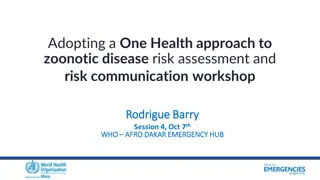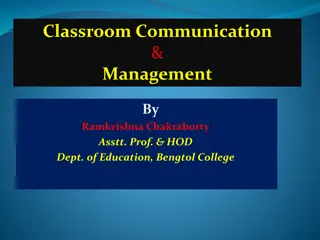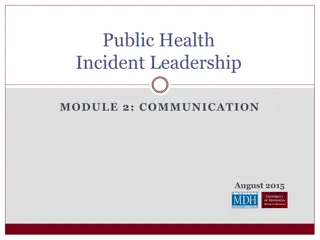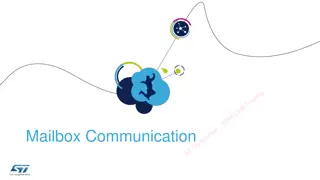
Communication & Health Education
Explore the key concepts of communication in health education, including definitions, importance, components, and more. Learn how effective communication can impact relationships, information sharing, and patient safety in healthcare settings.
Uploaded on | 1 Views
Download Presentation

Please find below an Image/Link to download the presentation.
The content on the website is provided AS IS for your information and personal use only. It may not be sold, licensed, or shared on other websites without obtaining consent from the author. If you encounter any issues during the download, it is possible that the publisher has removed the file from their server.
You are allowed to download the files provided on this website for personal or commercial use, subject to the condition that they are used lawfully. All files are the property of their respective owners.
The content on the website is provided AS IS for your information and personal use only. It may not be sold, licensed, or shared on other websites without obtaining consent from the author.
E N D
Presentation Transcript
Communication & Health Education
Outlines and objectives At the end of the lecture, you will be able to recognize concepts related to the following areas: Definition of communication Importance of communication Components of communication Models of communication Process of interpersonal; communication Theories of communication
Communication A dynamic, two ways circular process in which all types of information are shared between two or more people and their environment. 3
Definition of communication Communication, the process of transmitting thoughts, feelings, facts, and other information, includes verbal and nonverbal behavior. Stuart & Laraia (1998) describe communication as every aspect of behavior and, therefore, more than simply transmitting or imparting facts.
Importance off communication Communication fulfils several functions that are important for our well-being and survival. It helps us establish relationships, share information and ideas, and give meanings to everything we do. In the health care professions, communication assumes major significance in demonstrating a caring and a therapeutic approach.
Importance off communication Failure to give accurate and easily understood information, for example, can lead to anxiety and may have serious consequences where sensitive treatment are concerned. Miscommunication can lead to conflict and misunderstandings, and most importantly, can jeopardize patient safety.
In nursing, Communication is important to nursing practice since all nursing care involves some degree of communication.
Purpose of communication We need communication to understand & be understood.
Components of communication 1. 2. The stimulus : Reason for communication The sender : The individual who initiate the transmission of information. The message : The information, feelings, thought and ideas being sent and received. The medium : The method by which the message is sent). The receiver : The individual who both receives and interprets the message. The feed back: The measure by which the effectiveness of the message is gauged (evaluated). 3. 4. 5. 6. 9
Components of the Communication Process
1. The Sender The communication process begins when a person, known as the sender, generates a message. Messages stem from a person s need to relate to others, to create meanings, and to understand various situations. Messages are generated by external factors, such as what the sender sees, hears, touches, tastes, or smells.
However, the sender also perceives internal stimuli that generate messages. Examples of internal stimuli that affect communication include hunger, fatigue, or the mental activities of thinking and fantasizing (i.e., self-talk). The source (or encoder) is the stimulus, such as the idea, event, or situation. Encoding involves the use of language and other specific signs and symbols for sending messages.
2. The Message The message is a stimulus produced by a sender and responded to by a receiver. Messages may be verbal, nonverbal, written materials, and arts.
3. The Channel The channel is the medium through which a message is transmitted. There are three major communication channels: visual, auditory, and kinesthetic. The visual channel is sight, observation, and perception. The auditory channel consists of spoken words and cues. The kinesthetic channel refers to experiencing sensations. Each person has a dominant channel that influences communication
4. The Receiver The receiver is the person who intercepts the sender s message. Receiving is influenced by complex physiological, psychological, and cognitive processes.
The physiological component involves the process of hearing. Intact, healthy ears, as well as those areas of the brain involved in the hearing process, enable the receiver to hear messages. Good eyesight allows for the reception of messages via the visual channel. Likewise, homeostasis in those bodily structures where touch is applied allows for reception of those stimuli.
The psychological process refers to mental mechanisms that affect human behavior. This component may enhance or impede the receiving process. For example, anxiety may restrict the perceptual field, causing the client to hear, see, or feel less accurately. However, during mild and moderate levels of anxiety, the perceptual field broadens, causing the client to be more alert and to hear, see, or feel more.
The cognitive aspect is the thinking part of receiving and involves interpretation of stimuli, thus converting them into meaning. The receiver assigns meaning through his own brand of perceiving and self-talk, or communication with oneself. Engaging in too much self-talk may cause the receiver to do a poor job of listening. Controlling this self-talk requires continuous focusing and validating of the sender s message. Through cognitive processing, the receiver decodes messages, interprets them, and then provides feedback to the sender.
5. Feedback Feedback is the information the sender receives about the receiver s reaction to the message. The function of feedback is to provide the sender with information about the receiver s perception of a situation. Having this information, the sender can then adjust the delivery of the message to communicate more effectively. Communication is reciprocal in that both the sender and receiver must be involved; the sender must transmit the message, and the receiver must provide feedback for a communication to be complete.
CHARACTERISTICS OF EFFECTIVE FEEDBACK: Specific rather than general Descriptive Provided in a supportive, nonthreatening manner Given in a timely manner (as soon as possible after the behavior or the message) Usable and appropriate to client needs Clear and unambiguous Direct and honest
What is interpersonal communication? It is communication that occurs between persons who have connection. Communication occurs when you send or receive messages It is an interdependent process which means: what one person thinks and says impacts on what the other thinks and say.
It is always distorted by noise occurs within context and involves some opportunity for feed back. Occurs in each other and of their connection with each other. 23
Electronic Communication Advantages o Fast o Efficient o Legible o Improves communication, continuity of care Disadvantages o Client confidentiality risk o Socioeconomics
Do not use e-mail o Urgent information Jeopardy to client s health o Highly confidential information o Abnormal lab data Other guidelines o Agency-specific standards and guidelines o Part of medical record o Consent, identify as confidential
Effective Written Communication Does not convey nonverbal cues Same as verbal AND Appropriate language and terminology Correct grammar, spelling, punctuation Logical organization Appropriate use and citation of resources
The process of interpersonal communication 1. Sources receiver (at least two person exchange the communication . Messages (express thoughts, feelings, verbal or non verbal communication. Every message has an effect and outcome . Messages overload, feedback and feed forward 2.
3. Channel: the medium through which messages signals pass. The channels works like a bridge connecting source and receiver. 4. Noise 5. Context (the environment that influences the form and content of communication).
Noise It is any thing that interferes with your receiving a message that some one is sending or with their receiving your message. Noise may be: 1.Physical ( loud talking ,illegible hand writing ,garbage on your computer screen 2.Physiological ( hearing or visual impairment ) 3.Articulation disorders . Language speech disorder e.g. Cerebral palsy(CP), down syndrome , and Autism 4. Psychological (preconceived ideas ,wondering thoughts, biases). 5.Semantic (misunderstood meanings ). 29
Context It is an environment that influence the form and the content of communication ( natural e.g. street noise, or strict e.g funeral, quite place) . Context of communication has at least four dimensions. 1.Physical dimension: effect of physical when communicate, e.g. the room ,workplace readiness. 2.Cultural dimension: consist of rules ,norms, beliefs and attitudes of the people communicating that are passed from one generation to other (More details to come later) 30
3. Social-psychological dimension: include the status relationships among the participant e.g. who is the employer and employee, the formality or informality, the cooperativeness or the competitiveness of the interaction 4. Temporal or time dimension: It has to do with where a particular message fits into a sequence of communication events e.g. if you tell a joke about sickness immediately after your friend tells you she is sick, the joke will be perceived differently from the same joke told as a series of similar jokes to your friends in the locker room of the gym 31
Interpersonal competence The ability to communication effectively by mastering the skills of listening, critical thinking ,ethical foundation and power . The more words you know the more of ways you will have to express your self. The process goes like this: 1.Knowledge of interpersonal communication leads to greater interpersonal ability. 2.Leads to greater number of choices or option for interaction 3.Leads to greater interpersonal effectiveness 32
Six themes of competence 1. Interpersonal skills- large and ready collection of interpersonal skills that can be used as the situation warrants. 2. Power-skills for increasing and maintaining power and influence as will as the situation warrant. 3. Listening effectiveness of listening skills upon the situation. You cant be a competent communicator if you are a poor listener 33
4. Critical thinking- skills for thinking logically, intelligently and reasonable about communication & message appropriateness. It is the way of examining information and reaching a judgment and decision 5. Cultural sensitivity- or cultural competency .skills for communication effectively in intercultural situation 6. Ethical foundation- skills for communicating effectively with sound ethical principles. - Communicate with people in a unique valuable way 34
Principles of interpersonal communication another way to define communication is to consider its major principles 1. Package of signals involve verbal messages & gestures or together/ 2. Involves content and relationships messages (supervisor & trainee). Note :conflict may arise because of misunderstand relationship message. 3. Process of adjustment: This means sharing the same communication .e.g. learning the other person signals. 35
Principles of interpersonal communication Cont. Communication accommodation mean speakers will adjust to the style of their listeners so as to gain social approval and greater communication efficiency e.g. parents and children have different vocabularies and different meanings 4. Ambiguous: Having more than one meaning. Ambiguity results when we use words that can be interpreted differently Examples person might interpreted time terms differently example: Soon, right away, late. 36
5- Purposeful: Interpersonal communication serves various purposes: General purposes (inner circle) Motivation (middle circle) Results(outer circle) 37
General purposes (inner circle) Helps you to learn, and better understand the external world. Helps you relate, maintain close relationships, and find connections Helps you to influence the attitudes and behaviors of the others. Helps you to play and help other
Characteristics of interpersonal communication 1. Inevitable ( unavoidable) 2. Irreversible 3. Unrepeatable
1. Inevitable ( unavoidable) Sometimes you are communicating even though you may not think you are or you may not even want to. Example student sitting in the back of the room with expressionless face, the message he or she is sending or sharing involves lack of interest anxiety
2. Irreversible Although you may try to qualify deny or somehow reduce the effect of your message you cant withdraw message you have conveyed. Be carful not to say things you may wish to withdraw later
3. Unrepeatable Simply because everyone and everything are constantly changing. As a result you never can recapture the exact same situation, frame of mind or relationship dynamics that defined a previous interpersonal act.
Culture and interpersonal communication Culture: consist of the beliefs, ways of behaving that transmitted through communication and learning rather than through genes.
Gender: is considered a cultural variable at least in a part because culture teach boys and girls different attitude, beliefs, values and way of communication and relating to one another
The importance of culture People become more sensitive to cultural differences. They moved from Cultural assimilation (People should leave the native culture behind and adapt to their new culture) to a view that values cultural diversity (People should retain their native cultural ways).
The aim of cultural perspective A cultural emphasis helps to distinguish what is universal (true for all people) from what in relative (true for people in one culture and not true for people in another culture). communication with different cultures is knowing the cultural principles and ability to communicate, and adjust well based on cultural sensitivity and differences
The aim of cultural perspective- cont. Cultural perspectives influence: What you say to yourself and how you talk to others in everyday conversation. How you interact in a group. Topics you talk about Strategies you use in communicating information or in persuasion.
Theories of communication The linear view Interactional view Transactional
1. The linear view of human communication Some early theories viewed communication as linear which means the speaker spoke and the listener listened. After the speaker finished speaking, the listener would speak. Indicting one way communication-Active speaker and passive listener. Speaking and listening were seen as taking place at different times when you spoke you didn t listen and when you listen you didn t speak
2. Interactional view- interactive model In this view the speaker and the listener were seen as exchanging turns at speaking and listening Listener give feedback Communicators create and interpret messages 50






















